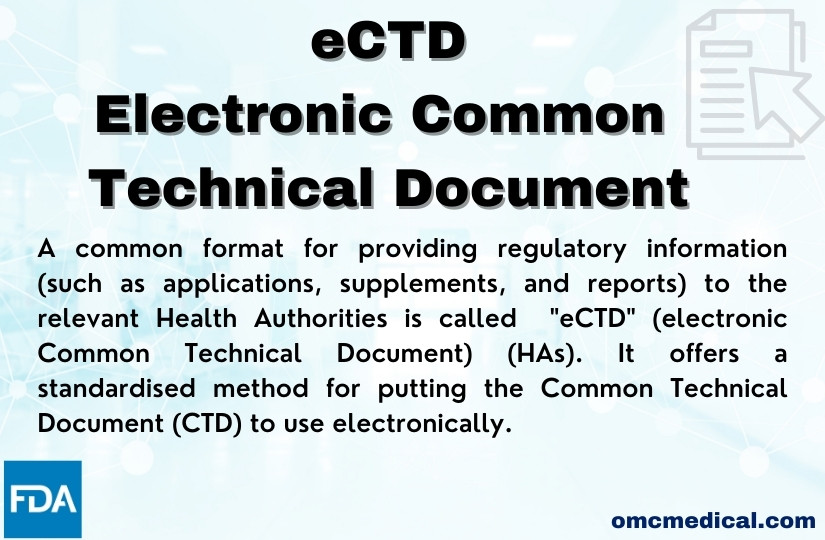eCTD-an overview
In today’s economy, life science companies are seeking for strategies to continue growing despite impending patent expirations, increasing generic competition, and rising drug development costs.
The International Conference on Harmonization (ICH) created the Common Technical Document (CTD), which is quickly replacing other submission formats as the preferred or compulsory one by regulators in the major global markets and beyond.
In Europe, Japan, and Canada, the CTD has been required for marketing and post-marketing applications since July 2003. Since 2008, the Food and Drug Administration (FDA) has required submissions in the eCTD format which adds additional parameters, such as PDF, transmission, file format, and supporting file specifications, to its requirements for eCTD submissions.
By the beginning of 2010, the European Medicines Agency (EMEA) expects all centralized Procedure applications to be submitted in the Electronic Common Technical Document format.
A worldwide interface and specification for the delivery of regulatory information from the pharmaceutical industry to agencies is the electronic common technical document.
The Electronic Common Technical Document Specification, the main standard developed by the ICH, substantially determines the structure of an Electronic Common Technical Document submission. However, in national and continental situations, further parameters might be used.
The eCTD has five modules:
- Administrative information and prescribing information.
- Common technical document summaries.
- Quality(CMC)
- Nonclinical study reports.
- Clinical study reports
There are two categories of modules:
- Regional module: 1 (different for each region; i.e., country)
- Common modules: 2–5 (common to all the regions)
The following are the main technological elements:
- A high-level folder structure
- An XML “backbone” file
- An optional lower-level folder structure (recommended folder names are provided in Appendix 4 of the Electronic Common Technical Document specification)
- Associated document type definitions (DTDs) and stylesheets
Checklist for eCTD Submission
- eCTD Software
- Software training and support from the supplier
- Compiling and Electronic Common Technical Document
- eCTD hyperlinking
- QC of Electronic Common Technical Document.
- Use the electronic gateway to submit your eCTD or a CD/DVD
eCTD Characteristics include:
- Granularity settings are available for all modules 1 through 5 to enable higher document granularity.
- PDF documents linked via XML backbone
- Transparency to the entire submission
- Ease of navigation and review
With the help of the eCTD’s features, submission and review periods can be sped up. One such feature is cross-application linking, which enables sponsors to submit a document just once and use it as many times as necessary in subsequent submissions and applications.
Cross-application linking is a crucial time-saving feature of an Electronic Common Technical Document because it enables the ability to reuse submission documents and to apply granular document updates to all linked occurrences elsewhere across related product applications (either while building the current submission or while applying a lifecycle attribute in a future sequence).
This lifecycle management capability boosts publisher productivity and helps maintain uniformity of information throughout the product application portfolio.
The ability of the eCTD to map to documents within and across all submissions and applications is one of the benefits of electronic transmission, administration, and storage.
If correctly configured and controlled from the beginning of the product IND application, this functionality can reduce time and costs.
Challenges
Despite all the advantages provided by the eCTD framework’s standardisation, there are still several drawbacks to this submission format that make it difficult for life sciences businesses to use.
Finding the regulatory tools that support the software abiding to the requirements for eCTD filing is the main challenge.
Other Challenges Include;
- Regional variations in the PDF version, bookmarking, and hyperlinking
- If the concerned employee quits, the product knowledge is lost.
- Lifecycle management is difficult.
- A consolidated approach to dossier drafting
- Baseline submissions are expensive and maybe of little benefit.
- Implementing last-minute modifications is challenging
Many pharmaceutical companies are making the switch to eCTD barely in time for regulatory deadlines, despite the fact that the industry has been preparing for change for some time.
Due to poor planning and understanding, many of the technical benefits of eCTD are sometimes lost as businesses struggle with new formats and procedures and fail to adequately plan for the product lifespan.
FAQS
Why eCTD is important?
By enabling sponsors to reuse and recycle previously published and submitted materials both inside a single submission and across all product applications, the eCTD format offers a platform for time savings and future product growth.







